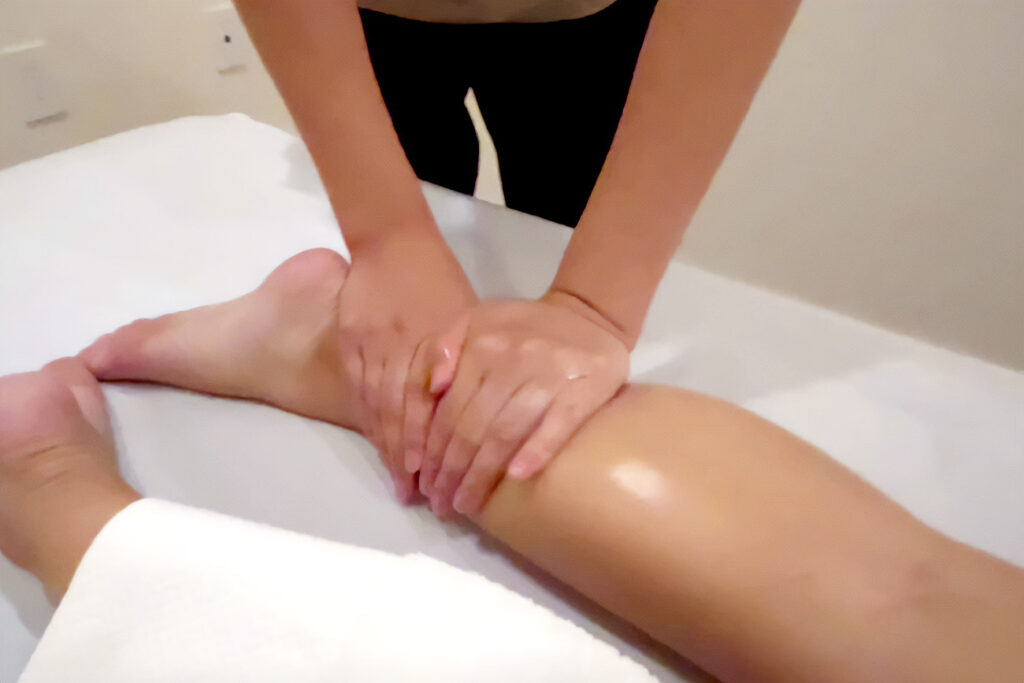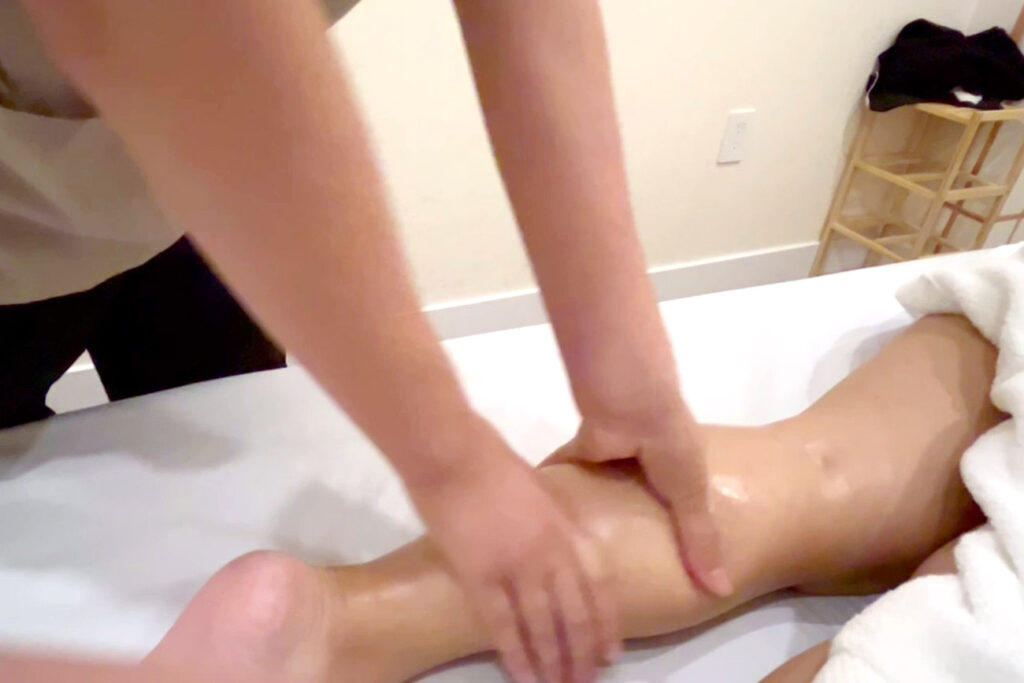Petrissage is one of the core massage techniques.
It is widely used in esthetics and massage, but do you know exactly what benefits it offers and what types there are?
This article explains petrissage in detail—from the basics and benefits to its variations and key precautions.
- [Tsubaki Massage Technique 1] What Is Petrissage?
- [Tsubaki Massage Technique 2] What Is Kneading?
- [Tsubaki Massage Technique 3] What Is Effleurage?
- [Tsubaki Massage Technique 4] What Is Friction?
- [Tsubaki Massage Technique 5] What Is Holding?
What Is Petrissage? Understanding the Basics

Petrissage is a specific manual technique used in massage and physical therapy. Originating from French, it resembles kneading bread dough: practitioners rhythmically lift, grasp, and knead the muscles and subcutaneous tissues. Beyond simple relaxation, it works on deeper structures and is believed to offer a range of benefits. In particular, it can relieve muscular tension, promote circulation, and increase tissue pliability. As such, it may help improve chronic shoulder and lower-back stiffness as well as swelling. During treatment, it is important to identify the target muscles and tissues and apply appropriate pressure and rhythm. Petrissage can be an effective approach for easing discomfort and supporting a healthier overall condition.
Definition and Etymology of Petrissage
“Pétrissage” comes from the French verb “pétrir,” meaning “to knead (dough).” As the origin suggests, the technique mimics kneading actions and is characterized by gently yet firmly grasping and working the muscles and subcutaneous tissues. In practice, the therapist uses the palms and fingers to grasp, lift, and knead the skin and muscles in a rhythmic sequence. Unlike purely superficial strokes, petrissage addresses deeper muscle layers and tissues, making it useful for relieving muscle tension and enhancing circulation. Historically used throughout Europe in therapeutic and cosmetic settings, its benefits have been increasingly recognized in recent years. Many massage therapists and physiotherapists in Japan now incorporate it. Petrissage is gaining attention not only for relaxation but also as a technique that improves function and promotes overall health.
Effleurage vs. Petrissage
Effleurage is another fundamental massage technique alongside petrissage. Derived from the French “effleurer” (“to skim/brush the surface”), effleurage involves gentle, gliding strokes over the skin. Petrissage, by contrast, involves grasping and kneading the muscles and subcutaneous tissues and therefore targets deeper structures than effleurage. Effleurage is often used at the beginning and end of a session to warm tissues and promote relaxation, and it can also encourage lymphatic flow to reduce swelling. Petrissage, which relieves muscle tension, stimulates circulation, and increases tissue flexibility, is commonly applied to address shoulder or low-back stiffness and muscular fatigue. In short, each technique has distinct purposes and effects.
Three Key Benefits of Petrissage

Petrissage can positively affect the body in several ways thanks to its distinctive mechanics.
Its main benefits include deep muscular relaxation and relief of stiffness, enhanced blood and lymphatic circulation, and improved muscular flexibility with greater range of motion. These effects reinforce one another to support overall well-being. As muscles relax, circulation improves, delivering oxygen and nutrients more efficiently to tissues. This facilitates the removal of metabolic waste and increases flexibility. Improved lymphatic flow also promotes waste clearance and helps reduce swelling. Together, these outcomes help alleviate discomfort and guide the body toward a healthier state.
Deep Muscular Relaxation and Relief of Stiffness
One of the most notable outcomes of petrissage is deep muscular relaxation and the easing of stiffness. Daily posture, prolonged desk work, and mental stress can tighten muscles. When muscles become rigid, they may compress blood vessels, restrict circulation, and limit oxygen and nutrient delivery, leading to waste buildup, stiffness, and pain. Rhythmic kneading in petrissage helps release muscular tension and promotes blood flow. With better circulation, oxygen and nutrients reach muscles more effectively and waste products are removed more readily, reducing discomfort and encouraging relaxation. Petrissage also influences the fascia—the connective tissue surrounding muscles. When fascia becomes tight, it can hinder smooth movement. By helping release fascial adhesions and restore elasticity, petrissage improves muscle glide and further reduces stiffness and pain.
Improved Blood and Lymphatic Circulation
Petrissage promotes both blood flow and lymphatic circulation. Kneading the tissues dilates blood vessels and increases local circulation, which enhances the delivery of oxygen and nutrients and supports cellular activity. It also facilitates the removal of carbon dioxide and metabolic by-products, aiding recovery from fatigue. By stimulating lymphatic pathways, petrissage encourages lymph flow, helping remove waste and excess fluids and thereby easing swelling in the limbs or face. Improved circulation and lymphatic drainage are also associated with healthier-looking skin by supporting nutrient delivery, normalizing turnover, and aiding the clearance of waste that contributes to dullness or breakouts.
Greater Flexibility and Range of Motion
Petrissage helps increase muscular flexibility and expand joint range of motion. Prolonged static postures and inactivity can stiffen muscles and reduce flexibility, which in turn restricts joint movement. By kneading the tissues, petrissage improves muscle suppleness and facilitates smoother joint motion. Better flexibility also supports injury prevention by helping muscles absorb impact and adapt to sudden movements—useful in sports and daily activities. As range of motion improves, everyday tasks become easier—for example, broader shoulder motion makes reaching or hanging laundry less strenuous, and better hip or spinal mobility eases lifting and bending. In this way, petrissage supports comfortable, functional movement in daily life.
Types and Techniques of Petrissage

Petrissage includes several variations, each with distinct characteristics. Representative types are kneading, rolling, shifting, and squeezing. These are selected according to the target area and treatment goals. Kneading, for instance, is commonly applied to larger muscle groups—such as the shoulders and thighs—to grasp and work the tissues, easing tightness and tension. Rolling involves lifting the skin and subcutaneous tissues with the fingers and “rolling” them, which can help firm the skin and is often used for cosmetic goals. Shifting moves the tissues side to side to widen joint range and reduce muscle tension. Squeezing applies compressive pressure to promote circulation and recovery from fatigue. Combining these techniques allows for more effective sessions tailored to each client’s condition.
Kneading (Kneading)
Kneading is one of the most fundamental forms of petrissage. Like kneading dough, it involves grasping and working the muscles. Using the palms and fingers, the therapist firmly grasps, lifts, and rhythmically compresses the tissues. It is often applied to larger muscle groups—such as the shoulders, back, and thighs—and works into deeper layers to relieve tension, stimulate circulation, and improve flexibility while easing stiffness and discomfort. Pressure and rhythm are adjusted to suit the client’s muscular condition.
Rolling
Rolling involves gently lifting the skin and subcutaneous tissues with the fingertips and then “rolling” them in rhythmic motions. Because it can help firm the skin, it is frequently used for cosmetic purposes. Rolling is especially effective on the thighs, hips, and upper arms. It encourages local circulation, supports lipid metabolism, and promotes lymphatic flow to assist with waste clearance.
Shearing
Shearing moves the muscles and surrounding tissues side to side. It is suitable for widening joint range of motion and easing muscular tension. The therapist uses the palms and fingers to grasp the tissues and gently sway them laterally. Shearing is effective around areas where joint motion is limited, such as the scapular region or hips. It relaxes muscles and ligaments around the joints, improves mobility, and promotes circulation. Pressure and tempo are matched to the client’s condition, often coordinated with breathing. Shearing is commonly combined with other petrissage methods.
Squeezing
Squeezing is a compressive technique applied to muscles and soft tissues. It promotes circulation and supports recovery from muscular fatigue. Using the palms and fingers, the therapist firmly grasps and compresses the tissues. Squeezing is often used on muscle-rich areas such as the calves, thighs, and arms. By enhancing intramuscular blood flow, it improves oxygen and nutrient delivery and encourages the removal of metabolic waste—useful after sports activity and for reducing swelling.
